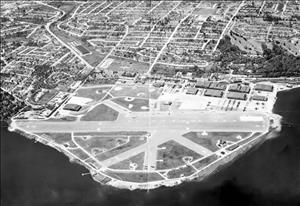On April 12, 1991, Secretary of Defense Dick Cheney recommends closure of the naval base at Sand Point, once again setting off a land fight. Magnuson Park supporters aim their attention at the entire 150 acres of land adjacent to the 195.6 acre park, as opposed to a 36.5 acre parcel previously freed for alternate uses. Meanwhile, the University of Washington becomes involved by proposing to use the brick naval buildings for housing and conferences.
The City of Seattle was responsible for coming up with a plan for usage of the naval base property. Mayor Norm Rice pledged an impartial public process to determine how it would be used.
The existing park was formed out of a large portion of the Sand Point Naval Air Station, which ended aviation operations in 1970. The remaining naval property became a support center for visiting ships and naval personnel.
A fight over whether the City should maintain an airport for light craft at Sand Point or whether it should be converted to a community park went on for years. The park was opened on May 29, 1977, as Warren G. Magnuson Park, named after the long-serving U.S. Senator. The National Oceanic and Atmospheric Administration also uses a 100-acre parcel for its Western headquarters.
The debate over uses for the naval property and Magnuson Park continued for many years after 1991 and is still (in the year 2000) not fully resolved, although the City Council passed a revised "final" plan on November 1, 1999. The struggle has involved the Muckleshoot Indians, who staked and then dropped their claim to the land; dog owners wanting off-leash areas; sport field advocates; neighbors; and many other interest groups.

